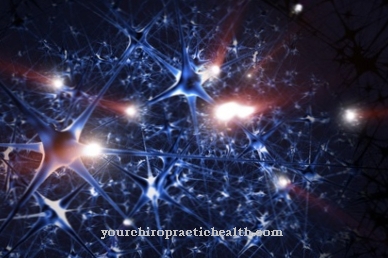In the first weeks and months of life, newborns have a large number of unconscious motor reaction patterns to certain stimuli. Of the Grasping reflex is one of them and consists of a forceful grip of the hand when touching and pressing the palm of the hand. The toes and the soles of the feet also curve in an indicated gripping movement when they touch the soles of the feet. Originally, the grasping reflex presumably served the reflexive clinging to the mother.
What is the grasping reflex?

Newborns have a variety of motor reflexes at birth. These are unconscious behavior patterns that are triggered by certain sensory stimuli. The development and disappearance of the reflexes is less dependent on the time of birth and more on the time of conception (conception age).
The grasping reflex can be subdivided into the hand and foot reflexes, which develop independently of each other and then disappear again. When the newborn's palm is touched and pressed, it unconsciously responds with a firm gripping movement of the fingers (closing of the fist).
The foot reflex is analogous to this. However, the foot reflex only consists of the curvature of the toes and flexion of the sole of the foot when touching and pressing on the sole of the foot, i.e. only an implied grasping movement. The possibilities of grasping with the feet have historically receded in humans.
The hand and foot reflexes are detectable from around the 32nd conception week and disappear in the hand at the latest in the 9th month of life and the foot reflexes disappear at the latest at the end of the first year of life or with learning to walk upright.
Function & task
In newborns, the central nervous system, especially the cerebrum, is not yet fully developed and not yet fully functional, because otherwise the size of the head would make the birth process even more problematic. Many of the necessary - especially motor - skills that later deliberately run consciously are replaced by unconsciously controlled reflexes, which are comparable to self-regulating control loops and are triggered by certain stimuli.
The most important function and the most important use of the grasping reflex, especially the hand-grasping reflex, was probably at an earlier stage in human development that the newborn could actively hold on to (cling to) the mother or rod-like or rope-like objects. This temporarily left the mother or another person with both hands free to do other things.
The foot reflex was probably also used for holding on and clinging, but only works rudimentary today because the mobility of the midbones of the foot and the length of the toes as well as the muscles have declined over the course of human development.
While the strong hand-grip reflex is still fully functional today and the baby can hold on to bars, ropes or even the mother's clothes during the first few months of life, the foot-grip reflex no longer fulfills this function. However, it can be used to maintain the rudimentary ability to grip with the foot through appropriate exercises during the transition to voluntary motor skills.
The grasping reflex serves less to reflexively hold onto objects than rather to enable one to hold onto oneself.
The foot reflex can also prove to be disturbing if it does not regress during the learning phase for upright walking. The child then has difficulty in putting all the weight on the foot because they instead want to constantly grip their foot and tend to try to stand on tiptoe and walk.
Illnesses & ailments
The neonatal reflexes in newborns - also called primitive reflexes - serve a wide variety of purposes. Some of the reflexes are e.g. B. only important prenatally in order to protect the baby from entanglement of the umbilical cord with the limbs before birth and to set the baby up in the best possible position for the birth by making certain movements.
Although the grasping reflex is not of primary importance for survival in humans today, it is nonetheless important that the reflex is mature at birth. An only weakly developed or completely absent grasping reflex indicates serious direct muscle or joint diseases or neuronal deficiencies that should definitely be clarified. As a rule, if the grasping reflex is not developed, other motor reflexes are also affected.
Usually, within the first few months of life, the primitive reflexes are gradually covered over and replaced by conscious motor actions. This happens through the increasing maturation of the neocortex and through a myelination of the afferent nerves, which can report sensory messages to the central nervous system faster than is possible via messages from the reflex arcs.
The reduction of the grasping reflex as well as the reduction of further reflexes only takes place properly if the child trains the reduction through constant multi-sensory learning, through conscious motor actions (e.g. playfully). In some children and even adults, remnants of the primitive reflexes have been retained, which can lead to impaired learning behavior, attention disorders and behavioral problems.
Weaknesses in arithmetic, reading and spelling are sometimes assigned to a lack of elimination of certain primitive reflexes. If z. If, for example, the foot reflex does not recede as a result of the toddler's attempts to walk, learning to stand and walk upright is extremely difficult. The foot tries again and again to arch inwards in an imaginary gripping movement when the sole of the foot is under load.












.jpg)



.jpg)










.jpg)
